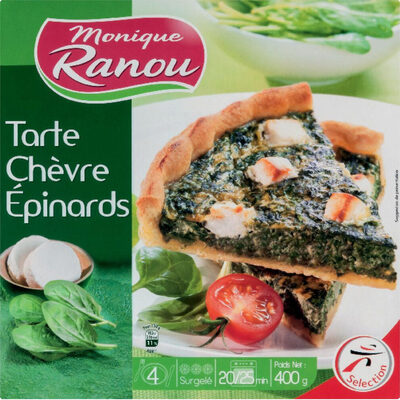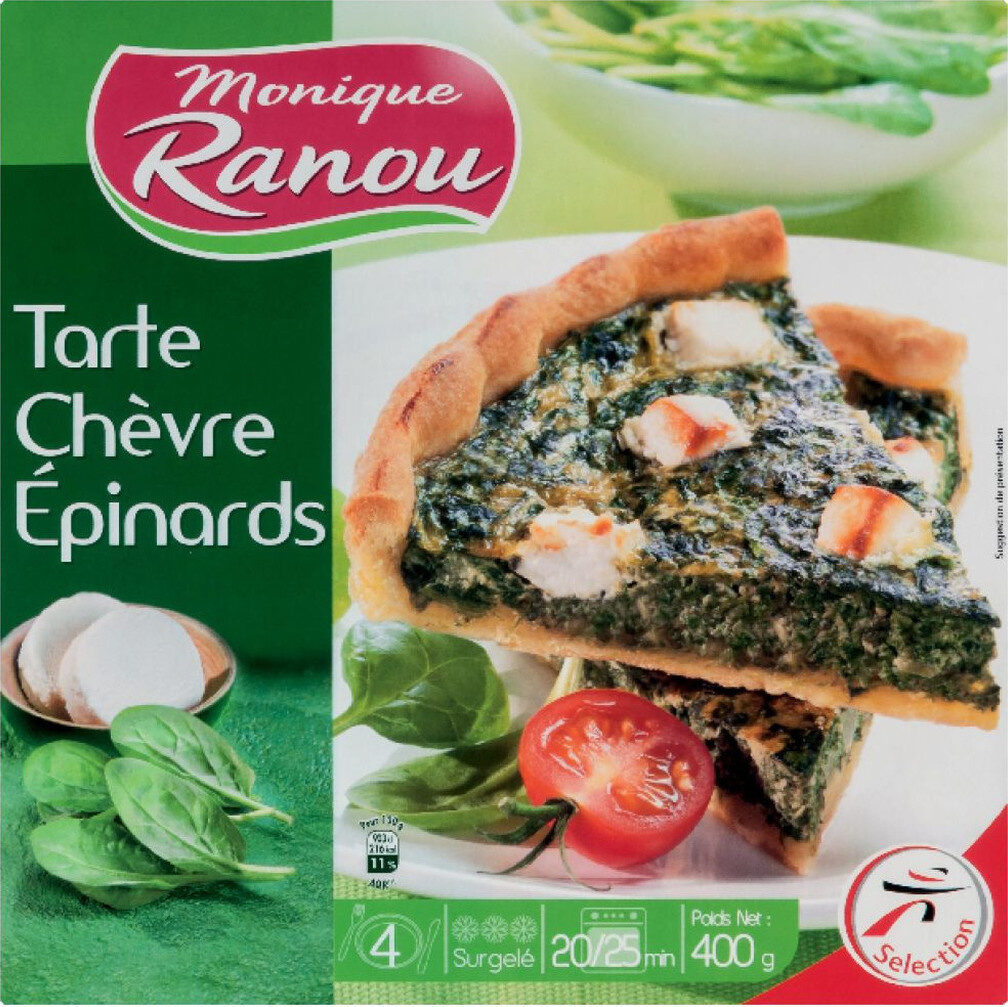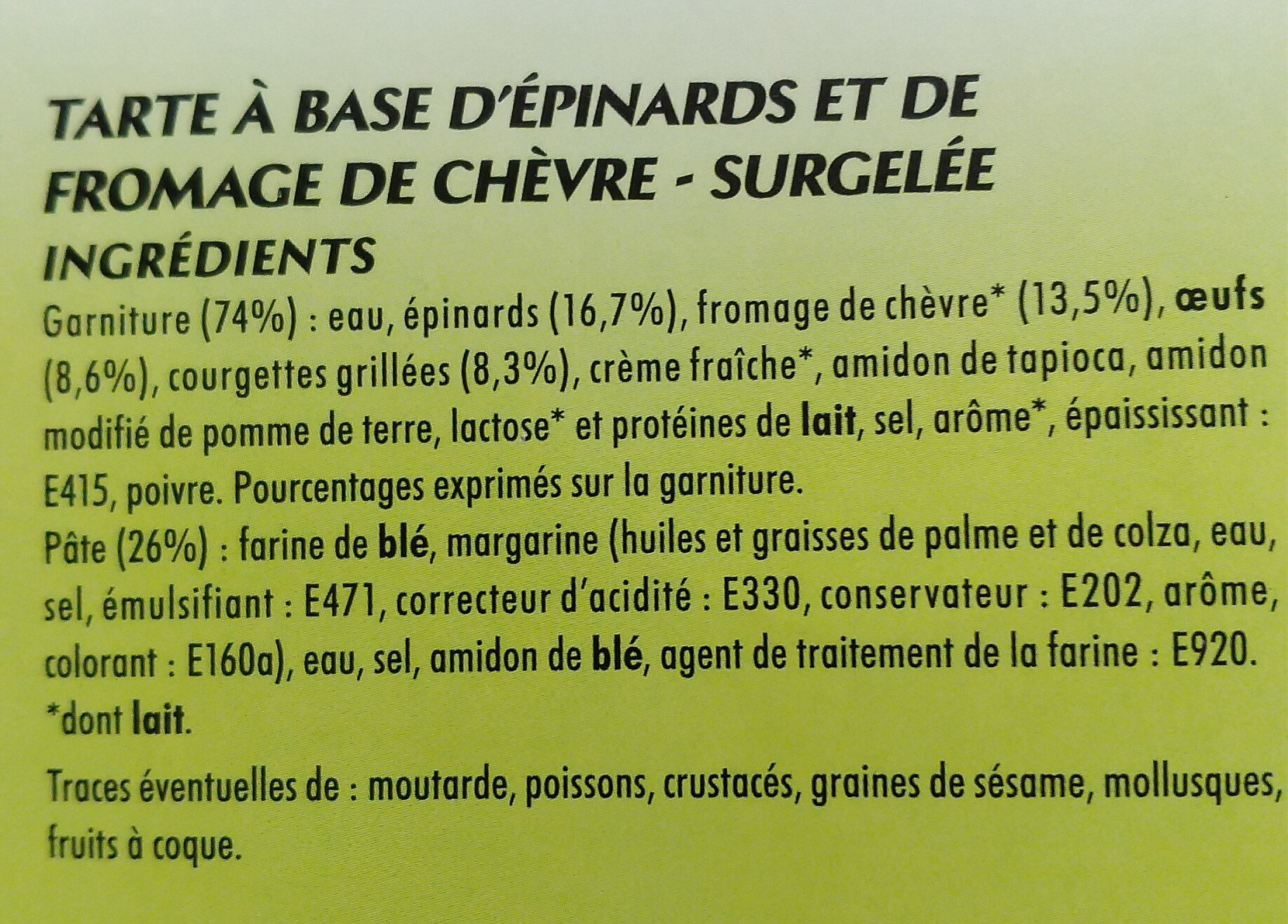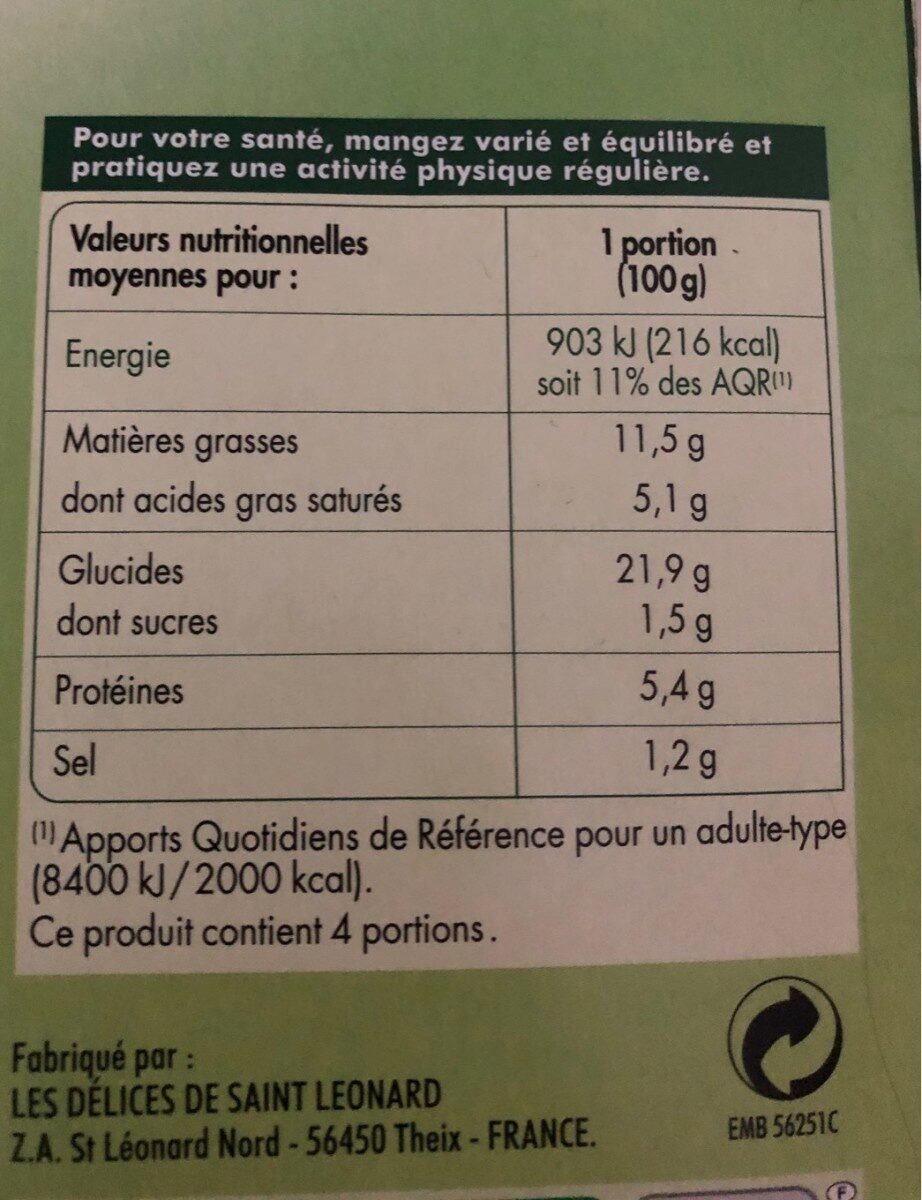Help us make food transparency the norm!
As a non-profit organization, we depend on your donations to continue informing consumers around the world about what they eat.
The food revolution starts with you!
Tarte chèvre épinards - Monique ranou - 400g
Tarte chèvre épinards - Monique ranou - 400g
This product page is not complete. You can help to complete it by editing it and adding more data from the photos we have, or by taking more photos using the app for Android or iPhone/iPad. Thank you!
×
Some of the data for this product has been provided directly by the manufacturer .
Barcode: 3250391394265 (EAN / EAN-13)
Quantity: 400g
Packaging: Frozen
Brands: Monique ranou
Categories: Meals, Pizzas pies and quiches, Salted pies, Pies, Cheese pies, fr:8400kj/2000KCAL
Traceability code: EMB 56251C - Theix (Morbihan, France)
Stores: Intermarché
Countries where sold: France
Matching with your preferences
Health
Ingredients
-
37 ingredients
: Garniture (74%): eau, épinards (16,7%), fromage de chèvre* (13,5%), oeufs (8,6%), courgettes grillées (8,3%), crème fraîche*, amidon de tapioca, amidon modifié de pomme de terre, lactose* et protéines de lait, sel, arôme*, épaississant: E415, poivre. Pourcentages exprimés sur la garniture. Pâte (26%): farine de blé, margarine (huiles et graisses de palme et de colza, eau, sel, émulsifiant: E471, correcteur d'acidité: E330, conservateur : E202, arôme, colorant : E160a), eau, sel, amidon de blé, agent de traitement de la farine : E920 *dont lait. Traces éventuelles de : moutarde, poissons, crustacés, graines de sésame, mollusques, fruits à coque.Allergens: Eggs, Gluten, MilkTraces: Crustaceans, Fish, Molluscs, Mustard, Nuts, Sesame seeds
Food processing
-
Ultra processed foods
Elements that indicate the product is in the 4 - Ultra processed food and drink products group:
- Additive: E14XX - Modified Starch
- Additive: E160a - Carotene
- Additive: E415 - Xanthan gum
- Additive: E471 - Mono- and diglycerides of fatty acids
- Ingredient: Colour
- Ingredient: Emulsifier
- Ingredient: Flavouring
- Ingredient: Lactose
- Ingredient: Milk proteins
- Ingredient: Thickener
Food products are classified into 4 groups according to their degree of processing:
- Unprocessed or minimally processed foods
- Processed culinary ingredients
- Processed foods
- Ultra processed foods
The determination of the group is based on the category of the product and on the ingredients it contains.
Additives
-
E160a - Carotene
Carotene: The term carotene -also carotin, from the Latin carota, "carrot"- is used for many related unsaturated hydrocarbon substances having the formula C40Hx, which are synthesized by plants but in general cannot be made by animals -with the exception of some aphids and spider mites which acquired the synthesizing genes from fungi-. Carotenes are photosynthetic pigments important for photosynthesis. Carotenes contain no oxygen atoms. They absorb ultraviolet, violet, and blue light and scatter orange or red light, and -in low concentrations- yellow light. Carotenes are responsible for the orange colour of the carrot, for which this class of chemicals is named, and for the colours of many other fruits, vegetables and fungi -for example, sweet potatoes, chanterelle and orange cantaloupe melon-. Carotenes are also responsible for the orange -but not all of the yellow- colours in dry foliage. They also -in lower concentrations- impart the yellow coloration to milk-fat and butter. Omnivorous animal species which are relatively poor converters of coloured dietary carotenoids to colourless retinoids have yellowed-coloured body fat, as a result of the carotenoid retention from the vegetable portion of their diet. The typical yellow-coloured fat of humans and chickens is a result of fat storage of carotenes from their diets. Carotenes contribute to photosynthesis by transmitting the light energy they absorb to chlorophyll. They also protect plant tissues by helping to absorb the energy from singlet oxygen, an excited form of the oxygen molecule O2 which is formed during photosynthesis. β-Carotene is composed of two retinyl groups, and is broken down in the mucosa of the human small intestine by β-carotene 15‚15'-monooxygenase to retinal, a form of vitamin A. β-Carotene can be stored in the liver and body fat and converted to retinal as needed, thus making it a form of vitamin A for humans and some other mammals. The carotenes α-carotene and γ-carotene, due to their single retinyl group -β-ionone ring-, also have some vitamin A activity -though less than β-carotene-, as does the xanthophyll carotenoid β-cryptoxanthin. All other carotenoids, including lycopene, have no beta-ring and thus no vitamin A activity -although they may have antioxidant activity and thus biological activity in other ways-. Animal species differ greatly in their ability to convert retinyl -beta-ionone- containing carotenoids to retinals. Carnivores in general are poor converters of dietary ionone-containing carotenoids. Pure carnivores such as ferrets lack β-carotene 15‚15'-monooxygenase and cannot convert any carotenoids to retinals at all -resulting in carotenes not being a form of vitamin A for this species-; while cats can convert a trace of β-carotene to retinol, although the amount is totally insufficient for meeting their daily retinol needs.Source: Wikipedia
-
E202 - Potassium sorbate
Potassium sorbate (E202) is a synthetic food preservative commonly used to extend the shelf life of various food products.
It works by inhibiting the growth of molds, yeast, and some bacteria, preventing spoilage. When added to foods, it helps maintain their freshness and quality.
Some studies have shown that when combined with nitrites, potassium sorbate have genotoxic activity in vitro. However, potassium sorbate is generally recognized as safe (GRAS) by regulatory authorities.
-
E330 - Citric acid
Citric acid is a natural organic acid found in citrus fruits such as lemons, oranges, and limes.
It is widely used in the food industry as a flavor enhancer, acidulant, and preservative due to its tart and refreshing taste.
Citric acid is safe for consumption when used in moderation and is considered a generally recognized as safe (GRAS) food additive by regulatory agencies worldwide.
-
E415 - Xanthan gum
Xanthan gum (E415) is a natural polysaccharide derived from fermented sugars, often used in the food industry as a thickening and stabilizing agent.
This versatile food additive enhances texture and prevents ingredient separation in a wide range of products, including salad dressings, sauces, and gluten-free baked goods.
It is considered safe for consumption even at high intake amounts.
-
E471 - Mono- and diglycerides of fatty acids
Mono- and diglycerides of fatty acids (E471), are food additives commonly used as emulsifiers in various processed foods.
These compounds consist of glycerol molecules linked to one or two fatty acid chains, which help stabilize and blend water and oil-based ingredients. E471 enhances the texture and shelf life of products like margarine, baked goods, and ice cream, ensuring a smooth and consistent texture.
It is generally considered safe for consumption within established regulatory limits.
-
E920 - L-cysteine
Cysteine: Cysteine -symbol Cys or C; - is a semi-essential proteinogenic amino acid with the formula HO2CCH-NH2-CH2SH. The thiol side chain in cysteine often participates in enzymatic reactions, as a nucleophile. The thiol is susceptible to oxidation to give the disulfide derivative cystine, which serves an important structural role in many proteins. When used as a food additive, it has the E number E920. It is encoded by the codons UGU and UGC. Cysteine has the same structure as serine, but with one of its oxygen atoms replaced by sulfur; replacing it with selenium gives selenocysteine. -Like other natural proteinogenic amino acids cysteine has -L- chirality in the older D/L notation based on homology to D and L glyceraldehyde. In the newer R/S system of designating chirality, based on the atomic numbers of atoms near the asymmetric carbon, cysteine -and selenocysteine- have R chirality, because of the presence of sulfur -resp. selenium- as a second neighbor to the asymmetric carbon. The remaining chiral amino acids, having lighter atoms in that position, have S chirality.-Source: Wikipedia
Ingredients analysis
-
Palm oil
Ingredients that contain palm oil: Palm oil, Palm fat
-
Non-vegan
Non-vegan ingredients: Goat cheese, Egg, Fresh cream, Lactose and milk proteinsSome ingredients could not be recognized.
We need your help!
You can help us recognize more ingredients and better analyze the list of ingredients for this product and others:
- Edit this product page to correct spelling mistakes in the ingredients list, and/or to remove ingredients in other languages and sentences that are not related to the ingredients.
- Add new entries, synonyms or translations to our multilingual lists of ingredients, ingredient processing methods, and labels.
If you would like to help, join the #ingredients channel on our Slack discussion space and/or learn about ingredients analysis on our wiki. Thank you!
-
Vegetarian status unknown
Unrecognized ingredients: Dough, Margarine, fr:graisses-de-colza, fr:e920-dont-laitSome ingredients could not be recognized.
We need your help!
You can help us recognize more ingredients and better analyze the list of ingredients for this product and others:
- Edit this product page to correct spelling mistakes in the ingredients list, and/or to remove ingredients in other languages and sentences that are not related to the ingredients.
- Add new entries, synonyms or translations to our multilingual lists of ingredients, ingredient processing methods, and labels.
If you would like to help, join the #ingredients channel on our Slack discussion space and/or learn about ingredients analysis on our wiki. Thank you!
-
Details of the analysis of the ingredients
We need your help!
Some ingredients could not be recognized.
We need your help!
You can help us recognize more ingredients and better analyze the list of ingredients for this product and others:
- Edit this product page to correct spelling mistakes in the ingredients list, and/or to remove ingredients in other languages and sentences that are not related to the ingredients.
- Add new entries, synonyms or translations to our multilingual lists of ingredients, ingredient processing methods, and labels.
If you would like to help, join the #ingredients channel on our Slack discussion space and/or learn about ingredients analysis on our wiki. Thank you!
: Garniture 74% (eau), épinards 16.7%, fromage de chèvre 13.5%, oeufs 8.6%, courgettes grillées 8.3%, crème fraîche, amidon de tapioca, amidon modifié de pomme de terre, lactose* et protéines de lait, sel, arôme, épaississant (e415), poivre, Pâte 26% (farine de blé), margarine (huiles de palme, graisses de palme, graisses de colza, eau, sel, émulsifiant (e471), correcteur d'acidité (e330), conservateur (e202), arôme, colorant (e160a)), eau, sel, amidon de blé, agent de traitement de la farine (e920 *dont lait)- Garniture -> en:filling - vegan: maybe - vegetarian: maybe - percent: 74
- eau -> en:water - vegan: yes - vegetarian: yes - ciqual_food_code: 18066
- épinards -> en:spinach - vegan: yes - vegetarian: yes - ciqual_food_code: 20059 - percent: 16.7
- fromage de chèvre -> en:goat-cheese - vegan: no - vegetarian: maybe - ciqual_proxy_food_code: 12999 - percent: 13.5
- oeufs -> en:egg - vegan: no - vegetarian: yes - ciqual_food_code: 22000 - percent: 8.6
- courgettes grillées -> en:grilled-courgette - vegan: yes - vegetarian: yes - ciqual_food_code: 20020 - percent: 8.3
- crème fraîche -> en:fresh-cream - vegan: no - vegetarian: yes - ciqual_food_code: 19402
- amidon de tapioca -> en:tapioca - vegan: yes - vegetarian: yes - ciqual_proxy_food_code: 9510
- amidon modifié de pomme de terre -> en:modified-potato-starch - vegan: yes - vegetarian: yes - ciqual_proxy_food_code: 9510
- lactose* et protéines de lait -> en:lactose-and-milk-proteins - vegan: no - vegetarian: yes
- sel -> en:salt - vegan: yes - vegetarian: yes - ciqual_food_code: 11058
- arôme -> en:flavouring - vegan: maybe - vegetarian: maybe
- épaississant -> en:thickener
- e415 -> en:e415 - vegan: yes - vegetarian: yes
- poivre -> en:pepper - vegan: yes - vegetarian: yes
- Pâte -> en:dough - percent: 26
- farine de blé -> en:wheat-flour - vegan: yes - vegetarian: yes - ciqual_proxy_food_code: 9410
- margarine -> en:margarine
- huiles de palme -> en:palm-oil - vegan: yes - vegetarian: yes - from_palm_oil: yes - ciqual_food_code: 16129
- graisses de palme -> en:palm-fat - vegan: yes - vegetarian: yes - from_palm_oil: yes - ciqual_proxy_food_code: 16129
- graisses de colza -> fr:graisses-de-colza
- eau -> en:water - vegan: yes - vegetarian: yes - ciqual_food_code: 18066
- sel -> en:salt - vegan: yes - vegetarian: yes - ciqual_food_code: 11058
- émulsifiant -> en:emulsifier
- e471 -> en:e471 - vegan: maybe - vegetarian: maybe - from_palm_oil: maybe
- correcteur d'acidité -> en:acidity-regulator
- e330 -> en:e330 - vegan: yes - vegetarian: yes
- conservateur -> en:preservative
- e202 -> en:e202 - vegan: yes - vegetarian: yes
- arôme -> en:flavouring - vegan: maybe - vegetarian: maybe
- colorant -> en:colour
- e160a -> en:e160a - vegan: maybe - vegetarian: maybe - from_palm_oil: maybe
- eau -> en:water - vegan: yes - vegetarian: yes - ciqual_food_code: 18066
- sel -> en:salt - vegan: yes - vegetarian: yes - ciqual_food_code: 11058
- amidon de blé -> en:wheat-starch - vegan: yes - vegetarian: yes - ciqual_proxy_food_code: 9510
- agent de traitement de la farine -> en:flour-treatment-agent
- e920 *dont lait -> fr:e920-dont-lait
Nutrition
-
Average nutritional quality
⚠ ️Warning: the amount of fruits, vegetables and nuts is not specified on the label, it was estimated from the list of ingredients: 25This product is not considered a beverage for the calculation of the Nutri-Score.
Positive points: 4
- Proteins: 3 / 5 (value: 5.7, rounded value: 5.7)
- Fiber: 1 / 5 (value: 1.3, rounded value: 1.3)
- Fruits, vegetables, nuts, and colza/walnut/olive oils: 0 / 5 (value: 25, rounded value: 25)
Negative points: 9
- Energy: 2 / 10 (value: 879, rounded value: 879)
- Sugars: 0 / 10 (value: 2, rounded value: 2)
- Saturated fat: 2 / 10 (value: 2.8, rounded value: 2.8)
- Sodium: 5 / 10 (value: 480, rounded value: 480)
The points for proteins are counted because the negative points are less than 11.
Nutritional score: (9 - 4)
Nutri-Score:
-
Nutrient levels
-
Fat in moderate quantity (9.5%)
What you need to know- A high consumption of fat, especially saturated fats, can raise cholesterol, which increases the risk of heart diseases.
Recommendation: Limit the consumption of fat and saturated fat- Choose products with lower fat and saturated fat content.
-
Saturated fat in moderate quantity (2.8%)
What you need to know- A high consumption of fat, especially saturated fats, can raise cholesterol, which increases the risk of heart diseases.
Recommendation: Limit the consumption of fat and saturated fat- Choose products with lower fat and saturated fat content.
-
Sugars in low quantity (2%)
What you need to know- A high consumption of sugar can cause weight gain and tooth decay. It also augments the risk of type 2 diabetes and cardio-vascular diseases.
Recommendation: Limit the consumption of sugar and sugary drinks- Sugary drinks (such as sodas, fruit beverages, and fruit juices and nectars) should be limited as much as possible (no more than 1 glass a day).
- Choose products with lower sugar content and reduce the consumption of products with added sugars.
-
Salt in moderate quantity (1.2%)
What you need to know- A high consumption of salt (or sodium) can cause raised blood pressure, which can increase the risk of heart disease and stroke.
- Many people who have high blood pressure do not know it, as there are often no symptoms.
- Most people consume too much salt (on average 9 to 12 grams per day), around twice the recommended maximum level of intake.
Recommendation: Limit the consumption of salt and salted food- Reduce the quantity of salt used when cooking, and don't salt again at the table.
- Limit the consumption of salty snacks and choose products with lower salt content.
-
-
Nutrition facts
Nutrition facts As sold
for 100 g / 100 mlAs sold
per serving (100g)Compared to: Cheese pies Energy 879 kj
(210 kcal)879 kj
(210 kcal)-18% Fat 9.5 g 9.5 g -37% Saturated fat 2.8 g 2.8 g -65% Carbohydrates 25 g 25 g +21% Sugars 2 g 2 g -14% Fiber 1.3 g 1.3 g +2% Proteins 5.7 g 5.7 g -35% Salt 1.2 g 1.2 g +28% Fruits‚ vegetables‚ nuts and rapeseed‚ walnut and olive oils (estimate from ingredients list analysis) 25 % 25 %
Environment
-
Eco-Score C - Moderate environmental impact
⚠ ️Select a country in order to include the full impact of transportation.The Eco-Score is an experimental score that summarizes the environmental impacts of food products.→ The Eco-Score was initially developped for France and it is being extended to other European countries. The Eco-Score formula is subject to change as it is regularly improved to make it more precise and better suited to each country.Life cycle analysis
-
Average impact of products of the same category: B (Score: 63/100)
Category: Cheese tart
Category: Cheese tart
- PEF environmental score: 0.40 (the lower the score, the lower the impact)
- including impact on climate change: 3.28 kg CO2 eq/kg of product
Stage Impact Agriculture
70.6 %Processing
11.8 %Packaging
2.6 %Transportation
4.3 %Distribution
2.3 %Consumption
8.5 %
Bonuses and maluses
-
Missing origins of ingredients information
Malus: -5
⚠ ️ The origins of the ingredients of this product are not indicated.
If they are indicated on the packaging, you can modify the product sheet and add them.
If you are the manufacturer of this product, you can send us the information with our free platform for producers.
-
Ingredients that threatens species
Malus: -10
Contains palm oil
Tropical forests in Asia, Africa and Latin America are destroyed to create and expand oil palm tree plantations. The deforestation contributes to climate change, and it endangers species such as the orangutan, the pigmy elephant and the Sumatran rhino.
-
Packaging with a low impact
Malus: -4
Shape Material Recycling Impact 1 Tray Heavy aluminium Medium 1 Box Non-corrugated cardboard Low 1 Film PP 5 - Polypropylene High
Eco-Score for this product
-
Impact for this product: C (Score: 44/100)
Product: Tarte chèvre épinards - Monique ranou - 400g
Life cycle analysis score: 63
Sum of bonuses and maluses: -19
Final score: 44/100
-
Carbon footprint
-
Equal to driving 1.7 km in a petrol car
328 g CO² per 100g of product
The carbon emission figure comes from ADEME's Agribalyse database, for the category: Cheese tart (Source: ADEME Agribalyse Database)
Stage Impact Agriculture
78.2 %Processing
8.0 %Packaging
3.2 %Transportation
6.7 %Distribution
1.1 %Consumption
2.8 %
Packaging
-
Packaging with a low impact
-
Packaging parts
1 x Tray (Aluminium: 8.2 g)
1 x Box (Non-corrugated cardboard: 39 g)
1 x Film (PP 5 - Polypropylene: 2.4 g)
-
Packaging materials
Material % Packaging weight Packaging weight per 100 g of product Paper or cardboard 78.6% 39 g 9.8 g Plastic 4.8% 2.4 g 0.6 g Metal 16.5% 8.2 g 2 g Total 100% 49.6 g 12.4 g
-
Transportation
-
Origins of ingredients
Missing origins of ingredients information
⚠ ️ The origins of the ingredients of this product are not indicated.
If they are indicated on the packaging, you can modify the product sheet and add them.
If you are the manufacturer of this product, you can send us the information with our free platform for producers.Add the origins of ingredients for this product Add the origins of ingredients for this product
Threatened species
-
Contains palm oil
Drives deforestation and threatens species such as the orangutan
Tropical forests in Asia, Africa and Latin America are destroyed to create and expand oil palm tree plantations. The deforestation contributes to climate change, and it endangers species such as the orangutan, the pigmy elephant and the Sumatran rhino.
Report a problem
-
Incomplete or incorrect information?
Category, labels, ingredients, allergens, nutritional information, photos etc.
If the information does not match the information on the packaging, please complete or correct it. Open Food Facts is a collaborative database, and every contribution is useful for all.
Data sources
Product added on by openfoodfacts-contributors
Last edit of product page on by chevalstar.
Product page also edited by didierszym, kiliweb, org-les-mousquetaires, packbot, raphael0202, roboto-app, teolemon, yuka.U2FRNUlQNEgvK1Fsbi9BaDd4VFkvb2hsNFo2a1Z6Mk9OZUVOSWc9PQ, yuka.sY2b0xO6T85zoF3NwEKvlkp5T9_M-ArjGzvvvHTayPW3cZ7qYstZvIujMag.










